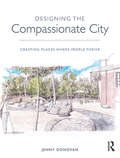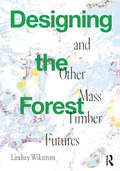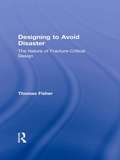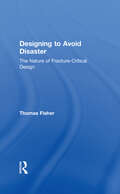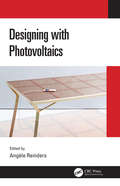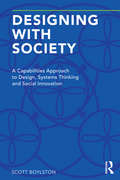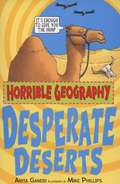- Table View
- List View
Designing the City of People 4.0: Reflections on strategic and sustainable urban design after Covid-19 pandemic (The City Project #1)
by Dario CostiThis book collects a set of reflections concerning the planning of contemporary cities by urban design, with a special emphasis on some needs and shortcomings emerged during the coronavirus pandemic. With the ultimate goal of designing accessible, inclusive and welcoming green cities, it discusses the urgent need for new systems of public spaces across the city, together with alternative solutions for individual mobility (especially slow mobility) and social interaction. It is intended for a broad readership, including designers, engineers, architects, social scientists, stakeholders, and public administrators, who deal with various aspects of the realization of the City 4.0.
Designing the Compassionate City: Creating Places Where People Thrive
by Jenny DonovanDesigning the Compassionate City outlines an approach to urban design that is centred on an explicit recognition of the inherent dignity of all people. It suggests that whether we thrive or decline—as individuals or as a community—is dependent on our ability to fulfil the full spectrum of our needs. This book considers how our surroundings help or hinder us from meeting these needs by influencing both what we can do and what we want to do; either inspiring us to lead healthy, fulfilled lives or consigning us to diminished lives tainted by ill health and unfulfilled potential. Designing the Compassionate City looks at how those who participate in designing towns and cities can collaborate with those who live in them to create places that help people to accumulate the life lessons, experiences and achievements, as well as forge the connections to meet their needs, to thrive and to fulfil their potential. The book explores a number of inspiring case studies that have sought to meet this challenge and examines what has worked and what hasn’t. From this, some conclusions are drawn about how we can all participate in creating places that leave a lasting legacy of empowerment and commitment to nurturing one another. It is essential reading for students and practitioners designing happier, healthier places.
Designing the Compassionate City: Creating Places Where People Thrive
by Jenny DonovanDesigning the Compassionate City outlines an approach to urban design that is centred on an explicit recognition of the inherent dignity of all people. It suggests that whether we thrive or decline—as individuals or as a community—is dependent on our ability to fulfil the full spectrum of our needs. This book considers how our surroundings help or hinder us from meeting these needs by influencing both what we can do and what we want to do; either inspiring us to lead healthy, fulfilled lives or consigning us to diminished lives tainted by ill health and unfulfilled potential. Designing the Compassionate City looks at how those who participate in designing towns and cities can collaborate with those who live in them to create places that help people to accumulate the life lessons, experiences and achievements, as well as forge the connections to meet their needs, to thrive and to fulfil their potential. The book explores a number of inspiring case studies that have sought to meet this challenge and examines what has worked and what hasn’t. From this, some conclusions are drawn about how we can all participate in creating places that leave a lasting legacy of empowerment and commitment to nurturing one another. It is essential reading for students and practitioners designing happier, healthier places.
Designing the Forest and other Mass Timber Futures
by Lindsey WikstromIf we want to continue existing on this earth, an era of renewable energy and materials is urgently needed. What role could mass timber, with its potential to replace concrete and steel, have in ensuring the planet’s survival? This book retraces wood’s passage from stewarded seed in the soil of forests, to harvested biomass, to laminated walls in a living room, through to its disassembly, pausing at each step in the supply chain of mass timber to consider the labor and economies involved, looking closely at the way wood is grown, sourced, and transported, and its impacts on the biodiversity of the forest and the health of our ecosystems. It explores why historically entrenched contexts of extractivism make such sensitive approaches difficult to cultivate across landscapes and industrial frameworks. Along the way, common assumptions about mass timber are debunked, including its fire performance, its strength, and its role in carbon sequestration. Having identified contemporary technical, cultural, and spiritual gaps preventing the transition towards a fully timber built environment, it outlines how we might move forward. A more sensitive species-based methodology is essential, with designers as choreographers of carbon, transferring and trading between forest, factory, site, and beyond. This will be an important read for anyone interested in our built environment and how to design it to be non-extractive, especially those with an interest in architecture, urbanism, forests, ecology, and timber, as well as students of architecture and design interested in the generative nature of materials and design processes.
Designing the Forest and other Mass Timber Futures
by Lindsey WikstromIf we want to continue existing on this earth, an era of renewable energy and materials is urgently needed. What role could mass timber, with its potential to replace concrete and steel, have in ensuring the planet’s survival? This book retraces wood’s passage from stewarded seed in the soil of forests, to harvested biomass, to laminated walls in a living room, through to its disassembly, pausing at each step in the supply chain of mass timber to consider the labor and economies involved, looking closely at the way wood is grown, sourced, and transported, and its impacts on the biodiversity of the forest and the health of our ecosystems. It explores why historically entrenched contexts of extractivism make such sensitive approaches difficult to cultivate across landscapes and industrial frameworks. Along the way, common assumptions about mass timber are debunked, including its fire performance, its strength, and its role in carbon sequestration. Having identified contemporary technical, cultural, and spiritual gaps preventing the transition towards a fully timber built environment, it outlines how we might move forward. A more sensitive species-based methodology is essential, with designers as choreographers of carbon, transferring and trading between forest, factory, site, and beyond. This will be an important read for anyone interested in our built environment and how to design it to be non-extractive, especially those with an interest in architecture, urbanism, forests, ecology, and timber, as well as students of architecture and design interested in the generative nature of materials and design processes.
Designing To Avoid Disaster: The Nature of Fracture-Critical Design
by Thomas FisherRecent catastrophic events, such as the I-35W bridge collapse, New Orleans flooding, the BP oil spill, Port au Prince's destruction by earthquake, Fukushima nuclear plant's devastation by tsunami, the Wall Street investment bank failures, and the housing foreclosure epidemic and the collapse of housing prices, all stem from what author Thomas Fisher calls fracture-critical design. This is design in which structures and systems have so little redundancy and so much interconnectedness and misguided efficiency that they fail completely if any one part does not perform as intended. If we, as architects, planners, engineers, and citizens are to predict and prepare for the next disaster, we need to recognize this error in our thinking and to understand how design thinking provides us with a way to anticipate unintended failures and increase the resiliency of the world in which we live. In Designing to Avoid Disaster, the author discusses the context and cultural assumptions that have led to a number of disasters worldwide, describing the nature of fracture-critical design and why it has become so prevalent. He traces the impact of fracture-critical thinking on everything from our economy and politics to our educational and infrastructure systems to the communities, buildings, and products we inhabit and use everyday. And he shows how the natural environment and human population itself have both begun to move on a path toward a fracture-critical collapse that we need to do everything possible to avoid. We designed our way to such disasters and we can design our way out of them, with a number of possible solutions that Fisher provides.
Designing To Avoid Disaster: The Nature of Fracture-Critical Design
by Thomas FisherRecent catastrophic events, such as the I-35W bridge collapse, New Orleans flooding, the BP oil spill, Port au Prince's destruction by earthquake, Fukushima nuclear plant's devastation by tsunami, the Wall Street investment bank failures, and the housing foreclosure epidemic and the collapse of housing prices, all stem from what author Thomas Fisher calls fracture-critical design. This is design in which structures and systems have so little redundancy and so much interconnectedness and misguided efficiency that they fail completely if any one part does not perform as intended. If we, as architects, planners, engineers, and citizens are to predict and prepare for the next disaster, we need to recognize this error in our thinking and to understand how design thinking provides us with a way to anticipate unintended failures and increase the resiliency of the world in which we live. In Designing to Avoid Disaster, the author discusses the context and cultural assumptions that have led to a number of disasters worldwide, describing the nature of fracture-critical design and why it has become so prevalent. He traces the impact of fracture-critical thinking on everything from our economy and politics to our educational and infrastructure systems to the communities, buildings, and products we inhabit and use everyday. And he shows how the natural environment and human population itself have both begun to move on a path toward a fracture-critical collapse that we need to do everything possible to avoid. We designed our way to such disasters and we can design our way out of them, with a number of possible solutions that Fisher provides.
Designing Water Disaster Management Policies: Theory and Empirics
by Chennat GopalakrishnanThis book represents a landmark effort to probe and analyze the theory and empirics of designing water disaster management policies. It consists of seven chapters that examine, in-depth and comprehensively, issues that are central to crafting effective policies for water disaster management. The author uses historical surveys, institutional analysis, econometric investigations, empirical case studies, and conceptual-theoretical discussions to clarify and illuminate the complex policy process.The specific topics studied in this book include a review and analysis of key policy areas and research priority areas associated with water disaster management, community participation in disaster risk reduction, the economics and politics of ‘Green’ flood control, probabilistic flood forecasting for flood risk management, polycentric governance and flood risk management, drought management with the aid of dynamic inter-generational preferences, and how social resilience can inform SA/SIA for adaptive planning for climate change in vulnerable areas.A unique feature of this book is its analysis of the causes and consequences of water disasters and efforts to address them successfully through policy-rich, cross-disciplinary and transnational papers. This book is designed to help enrich the sparse discourse on water disaster management policies and galvanize water professionals to craft creative solutions to tackle water disasters efficiently, equitably, and sustainably. This book should also be of considerable use to disaster management professionals, in general, and natural resource policy analysts.This book was published as a special issue of the Journal of Natural Resource Policy Research.
Designing Water Disaster Management Policies: Theory and Empirics
by Chennat GopalakrishnanThis book represents a landmark effort to probe and analyze the theory and empirics of designing water disaster management policies. It consists of seven chapters that examine, in-depth and comprehensively, issues that are central to crafting effective policies for water disaster management. The author uses historical surveys, institutional analysis, econometric investigations, empirical case studies, and conceptual-theoretical discussions to clarify and illuminate the complex policy process.The specific topics studied in this book include a review and analysis of key policy areas and research priority areas associated with water disaster management, community participation in disaster risk reduction, the economics and politics of ‘Green’ flood control, probabilistic flood forecasting for flood risk management, polycentric governance and flood risk management, drought management with the aid of dynamic inter-generational preferences, and how social resilience can inform SA/SIA for adaptive planning for climate change in vulnerable areas.A unique feature of this book is its analysis of the causes and consequences of water disasters and efforts to address them successfully through policy-rich, cross-disciplinary and transnational papers. This book is designed to help enrich the sparse discourse on water disaster management policies and galvanize water professionals to craft creative solutions to tackle water disasters efficiently, equitably, and sustainably. This book should also be of considerable use to disaster management professionals, in general, and natural resource policy analysts.This book was published as a special issue of the Journal of Natural Resource Policy Research.
Designing Wind Turbines: Engineering and Manufacturing Process in the Industrial Context (Synthesis Lectures on Renewable Energy Technologies)
by Uwe Ritschel Michael BeyerDesigning a wind turbine is an interdisciplinary process that requires an understanding of challenges for all parties involved. The authors deliver an effective and economic way to organize such a design by respecting all the challenges involved. The book provides such insight by utilizing specific examples of existing modern designs. Detailed descriptions and explanations are given for those components of the wind turbine that are normally developed by the so-called original equipment manufacturers (OEM) of a particular type. The OEM needs to have full knowledge of the complete system that consists of all parts being rotor blades, nacelle, drive train, tower, and foundation including the dynamic properties and the response to the controller action. This full knowledge is called system competence. For a wind turbine the drive train is the most important system. It consists of many components like shafts, bearings, gearbox, and generator for a wind turbine with a gear box; in systems without a gearbox a large generator has to be integrated into the drive train.
Designing with Photovoltaics
by Angèle Reinders"Designing with Photovoltaics" cover a broad range of topics related to the design of products, buildings and vehicles with integrated photovoltaic (PV) technologies including storage aspect. It enables the reader to easily design new products, buildings and vehicles through use of innovative PV products. Diverse categories of product integrated PVs are discussed including applications of solar power for mobility and building integrated systems along with design- and manufacturing-related information about solar cells. Illustrating design cases of various PV-powered products, special attention is paid to end-users and environmental aspects of PV applications. Aimed at senior undergraduates, graduates and professionals in electrical engineering, architecture, design, physics, mechanical engineering and those specifically studying photovoltaics, it Covers the different product integrated photovoltaics (PIPV) with a focus on design and manufacturing Presents comprehensive overview of all aspects of designing with photovoltaics Includes product integrated PV, building integrated PV and solar powered mobility concepts Contains real design cases showing how to design with photovoltaics Discusses context of environmental issues and user aspects
Designing with Photovoltaics
by Angèle Reinders"Designing with Photovoltaics" cover a broad range of topics related to the design of products, buildings and vehicles with integrated photovoltaic (PV) technologies including storage aspect. It enables the reader to easily design new products, buildings and vehicles through use of innovative PV products. Diverse categories of product integrated PVs are discussed including applications of solar power for mobility and building integrated systems along with design- and manufacturing-related information about solar cells. Illustrating design cases of various PV-powered products, special attention is paid to end-users and environmental aspects of PV applications. Aimed at senior undergraduates, graduates and professionals in electrical engineering, architecture, design, physics, mechanical engineering and those specifically studying photovoltaics, it Covers the different product integrated photovoltaics (PIPV) with a focus on design and manufacturing Presents comprehensive overview of all aspects of designing with photovoltaics Includes product integrated PV, building integrated PV and solar powered mobility concepts Contains real design cases showing how to design with photovoltaics Discusses context of environmental issues and user aspects
Designing with Society: A Capabilities Approach to Design, Systems Thinking and Social Innovation
by Scott BoylstonThis book explores an emerging design culture that rigorously applies systems thinking to the practice of design as a form of facilitating change on an increasingly crowded planet. Designers conversant in topics such as living systems, cultural competence, social justice, and power asymmetries can contribute their creative skills to the world of social innovation to help address the complex social challenges of the 21st century. By establishing a foundation built on the capabilities approach to human development, designers have an opportunity to transcend previous disciplinary constraints, and redefine our understanding of design agency. With an emphasis on developing an adaptability to dynamic situations, the cultivation of diversity, and an insistence on human dignity, this book weaves together theories and practices from diverse fields of thought and action to provide designers with a concrete yet flexible set of actionable design principles. And, with the aim of equipping designers with the ability to drive long-term, sustainable change, it proposes a new set of design competences that emphasize a deeper mindfulness of our interdependence; with each other, and with our life-giving natural systems. It’s a call to action to use design and design thinking as a tool to transform our collective worldviews toward an appreciation for what we all hold in common; a hope and a belief that our future is a place where all of humankind will flourish.
Designing with Society: A Capabilities Approach to Design, Systems Thinking and Social Innovation
by Scott BoylstonThis book explores an emerging design culture that rigorously applies systems thinking to the practice of design as a form of facilitating change on an increasingly crowded planet. Designers conversant in topics such as living systems, cultural competence, social justice, and power asymmetries can contribute their creative skills to the world of social innovation to help address the complex social challenges of the 21st century. By establishing a foundation built on the capabilities approach to human development, designers have an opportunity to transcend previous disciplinary constraints, and redefine our understanding of design agency. With an emphasis on developing an adaptability to dynamic situations, the cultivation of diversity, and an insistence on human dignity, this book weaves together theories and practices from diverse fields of thought and action to provide designers with a concrete yet flexible set of actionable design principles. And, with the aim of equipping designers with the ability to drive long-term, sustainable change, it proposes a new set of design competences that emphasize a deeper mindfulness of our interdependence; with each other, and with our life-giving natural systems. It’s a call to action to use design and design thinking as a tool to transform our collective worldviews toward an appreciation for what we all hold in common; a hope and a belief that our future is a place where all of humankind will flourish.
Designing Zero Carbon Buildings: Embodied and Operational Emissions in Achieving True Zero
by Ljubomir JankovicIn this significantly revised third edition, Designing Zero Carbon Buildings combines embodied and operational emissions into a structured approach for achieving zero emissions by a specific year with certainty.Simulation and quantitative methods are introduced in parallel with analogue scale models to demonstrate how things work in buildings. Where equations are provided, this is also explained with common analogue objects, pictures, and narratives. A Zero Equation introduced in this book is not only explained as an equation but also as an analogy with a jam jar and spoons, making the book accessible for a range of audiences. Tasks for simple experiments, exercises, discussion questions, and summaries of design principles are provided in closing lines of chapters.This book introduces new case studies, in addition to an updated case study of the Birmingham Zero Carbon House, applying embodied and operational emissions to assess their status using the Zero Equation. The approach introduced brings about a sense of realism into what true zero emissions mean. Written for students, educators, architects, engineers, modellers, practising designers, sustainability consultants, and others, it is a major positive step towards design thinking that makes achieving zero carbon emissions a reality.
Designing Zero Carbon Buildings: Embodied and Operational Emissions in Achieving True Zero
by Ljubomir JankovicIn this significantly revised third edition, Designing Zero Carbon Buildings combines embodied and operational emissions into a structured approach for achieving zero emissions by a specific year with certainty.Simulation and quantitative methods are introduced in parallel with analogue scale models to demonstrate how things work in buildings. Where equations are provided, this is also explained with common analogue objects, pictures, and narratives. A Zero Equation introduced in this book is not only explained as an equation but also as an analogy with a jam jar and spoons, making the book accessible for a range of audiences. Tasks for simple experiments, exercises, discussion questions, and summaries of design principles are provided in closing lines of chapters.This book introduces new case studies, in addition to an updated case study of the Birmingham Zero Carbon House, applying embodied and operational emissions to assess their status using the Zero Equation. The approach introduced brings about a sense of realism into what true zero emissions mean. Written for students, educators, architects, engineers, modellers, practising designers, sustainability consultants, and others, it is a major positive step towards design thinking that makes achieving zero carbon emissions a reality.
Designing Zero Carbon Buildings Using Dynamic Simulation Methods
by Ljubomir JankovicIn addition to the application of fundamental principles that lead to a structured method for zero carbon design of buildings, this considerably expanded second edition includes new advanced topics on multi-objective optimisation; reverse modelling; reduction of the simulation performance gap; predictive control; nature-inspired emergent simulation leading to sketches that become ‘alive’; and an alternative economics for achieving the sustainability paradigm. The book features student design work from a Master’s programme run by the author, and their design speculation for a human settlement on Mars. Tasks for simple simulation experiments are available for the majority of topics, providing the material for classroom exercise and giving the reader an easy introduction into the field. Extended new case studies of zero carbon buildings are featured in the book, including schemes from Japan, China, Germany, Denmark and the UK, and provide the reader with an enhanced design toolbox to stimulate their own design thinking.
Designing Zero Carbon Buildings Using Dynamic Simulation Methods
by Ljubomir JankovicIn addition to the application of fundamental principles that lead to a structured method for zero carbon design of buildings, this considerably expanded second edition includes new advanced topics on multi-objective optimisation; reverse modelling; reduction of the simulation performance gap; predictive control; nature-inspired emergent simulation leading to sketches that become ‘alive’; and an alternative economics for achieving the sustainability paradigm. The book features student design work from a Master’s programme run by the author, and their design speculation for a human settlement on Mars. Tasks for simple simulation experiments are available for the majority of topics, providing the material for classroom exercise and giving the reader an easy introduction into the field. Extended new case studies of zero carbon buildings are featured in the book, including schemes from Japan, China, Germany, Denmark and the UK, and provide the reader with an enhanced design toolbox to stimulate their own design thinking.
Desktop Mapping: Grundlagen und Praxis in Kartographie und GIS
by Gerold Olbrich Michael Quick Jürgen SchweikartSchätzungsweise 80% aller verfügbaren Daten haben geographischen Bezug. Dank der rasanten Entwicklung von Hard- und Software ist es heute leichter denn je, diese raumbezogenen Daten als Karte abzubilden. Zunehmend bedienen sich daher heute auch Praktiker und Wissenschaftler ohne spezielle Kartographiekenntnisse dieser Form der Darstellung. Dem Leser wird zunächst unverzichtbares Basiswissen aus dem Bereich der thematischen Kartographie vermittelt und darauf aufbauend die Methodik der angewandten digitalen Kartographie erläutert. Wie sieht ein kartographischer PC-Arbeitsplatz aus? Wie kommen die Daten in den PC? Wie wird eine Karte daraus und wie kommt diese anschließend auf den Drucker oder ins Internet? Diese Fragen werden in einem separaten Kapitel zur angewandten digitalen Kartographie beantwortet. Ein ausführlicher Überblick über gängige Software rundet das Buch ab. Die beiliegende CD-ROM enthält Demoversionen zu diesen Programmen.
Desktop Publishing: Anwendungen, Erfahrungen, Prognosen
by Uwe PapeExperten berichten in diesem Buch über den Einsatz von Desktop-Publishing-Systemen. Im Vordergrund stehen dabei Aspekte der Software sowie Anwendungen im graphischen Gewerbe, im CAD-Bereich, in der öffentlichen Verwaltung sowie in Klein- und Mittelbetrieben. Das Buch ist eine wertvolle Hilfe für alle, die den Einsatz eines DTP-Systems planen und Trends in ihre Entscheidung einbeziehen wollen.
Desperate Deserts (PDF)
by Anita Ganeri Mike PhillipsGeography with the gritty bits left in! Where in the world can you: Spot sand dunes that bury whole villages? Discover some deadly desert wildlife? Follow in the footsteps of daring desert explorers?
The Destruction of Sodom, Gomorrah, and Jericho: Geological, Climatological, and Archaeological Background
by David Neev K. O. EmeryThe story of the destruction of Sodom, Gomorrah, and Jericho--three cities situated along a major fault line extending 1,100 kilometers from the Red Sea to Turkey--is the oldest such description in human history. In this book, noted geologists K.O. Emery and David Neev have revisited that story to shed light on what happened there some 4,350 years ago. With all the benefits of modern geological and forensic science techniques at their disposal, the authors explore an area where earthquakes, volcanic activity, variations in the Dead Sea's level, and oscillations between arid and wet climates have affected life there for over 10,000 years. In reviewing the geology, biblical paleogeography, and limnology of the region, the authors have produced fascinating insights into the tectonic and climatic changes that have occurred in the region over the last 6,000 years and how those changes have affected cultural life in the Middle East. The Destruction of Sodom, Gomorrah, and Jericho is the first book to combine modern science and biblical archaeology to produce an authoritative account of the of these three great cities. It will fascinate students and researchers in geology, geophysics, and archaeology alike.
Destructive Margin (large print)
by RnibThis diagram is a cross section of a destructive margin showing the Earth's mantle, two tectonic plates and the ocean. There is a locator dot shown, which will be at the top left of the page when the image is the right way up. Each object is labelled and the diagram is framed by a dashed line image border. The Earth's mantle stretches across the bottom of the page. Above this, on each side of the page, there are tectonic plates that are moving towards one another, with their directions of movement indicated by arrows. The plate at the left tips down the page as it meets the plate to the right. Up from this plate, the ocean is shown. To the right is the gap of an ocean trench between the plates, and to the right again is the other plate with a volcano spewing magma into the air. To the right of this is a fold mountain. The area in the mantle down the page from the volcano is the subduction zone. This is where the plate on the right is pushed down into the mantle and becomes molten.
Destructive Margin (tactile)
by RnibThis diagram is a cross section of a destructive margin showing the Earth's mantle, two tectonic plates and the ocean. There is a locator dot shown, which will be at the top left of the page when the image is the right way up. Each object is labelled and the diagram is framed by a dashed line image border. The Earth's mantle stretches across the bottom of the page. Above this, on each side of the page, there are tectonic plates that are moving towards one another, with their directions of movement indicated by arrows. The plate at the left tips down the page as it meets the plate to the right. Up from this plate, the ocean is shown. To the right is the gap of an ocean trench between the plates, and to the right again is the other plate with a volcano spewing magma into the air. To the right of this is a fold mountain. The area in the mantle down the page from the volcano is the subduction zone. This is where the plate on the right is pushed down into the mantle and becomes molten.
Destructive Plate (tactile)
by RnibThis is a tactile diagram for GCSE students. It shows a cross-section of the Earth's crust, with the movement of two tectonic plates pushing together. Labels explain how mountains and new volcanoes can form with the movement of the plates.

